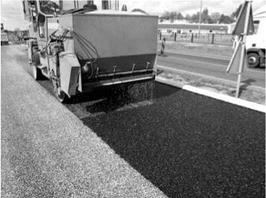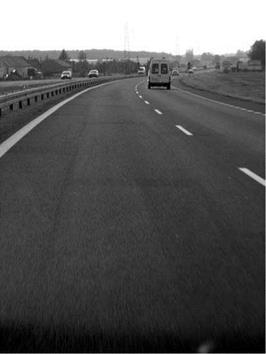Gritting Execution
Grit is spread on an hot SMA mixture using one of the two following techniques:
• With a gritter installed on a roller, during the first pass of the roller there is no gritting, but during the second pass the gritting is turned on. One should remember to grit in one direction of roller movement, and to not grit when returning; when using that technique, grit particles are pressed into the hot SMA mixture (Figure 10.15).
• With a self-propelled gritter, gritting starts after rolling the layer down with the rollers, when the SMA is still hot enough and prior to the last pass of the roller. This method is seldom used.
Remember that the quantity of grit per square meter has been established for a given machine (a gritter) and for a specific passing speed. Any change to the speed
|
FIGURE 10.15 SMA gritters installed on rollers—the gap gritter. (Photo courtesy of Bartosz Wojczakowski.) |
|
FIGURE 10.16 Movement traces of a roller after gritting a freshly made SMA layer. (Photo courtesy of Krzysztof Blazejowski.) |
results in a change in the quantity of grit applied to the layer. The minimum temperature of a layer being gritted is 110°C; below that temperature the grit is unlikely to stick to the SMA (Jacobs and Fafie, 2004).
Figure 10.16 shows movement traces of a roller fitted with a gritter. Spots where the roller has changed direction before the gritter was fully disengaged are visible. This is not a substantial mistake of execution; at most it is likely to spoil the aesthetic impressions of some road users. After gritting and cooling of the layer, excess grit aggregate or unbonded grit should be removed, (e. g., by sweeping).
Research has proved that gritting makes sense since it enhances SMA antiskidding performance in the initial period after pavement construction. When gritting is not used, better coefficients of friction are available with SMA 0/8 mm than with SMA 0/11 mm (more contact points between SMA and tire). It should be mentioned additionally that the application of gritting influences the macrotexture during the first period after construction. Grains and crushed particles of grit occupy spaces between coarse grains and decrease the macrotexture depth.
Finally, it should be clearly stated that gritting is not a way to cover or hide fat spots occurring on SMA surfaces during placement. In some cases, even gritting is not likely to conceal a fat spot, since gritting would be “drowned” in an excess of mastic (Figure 10.17).
|
FIGURE 10.17 Gritting of chippings 2/5 mm applied over a fat spot of mastic. (Photo courtesy of Krzysztof Blazejowski.) |









Leave a reply